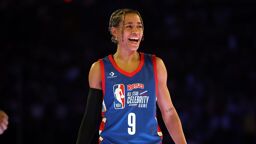The National Women’s Hockey League has officially adopted a policy that lays out a path to participation for transgender athletes.
Earlier this year one of the league’s players, Harrison Browne, came out as a trans man. Since that day the league has been working quickly to create rules around trans athletes and a path to participation for trans women.
The policy allows anyone born female at birth, who is not taking testosterone hormone therapy, to compete. This includes Browne. Anyone born male at birth must take testosterone inhibitors and is subjected to testosterone testing throughout their participation in the league. Most notably, no gender-reassignment surgery is required for participation.
The full policy is listed below.
Chris Mosier, who has helped guide numerous organizations on trans-inclusion policies and who had his hand in this one along with the National Center for Lesbian Rights, told Outsports he believes this is “the most inclusive gender policy in women's professional sports.”
Mosier was named Outsports’ person of the year for 2016 for his role in breaking down barriers across sports for trans athletes.
"Transgender women are women,” Mosier said. “When we respect a player’s identity, name, and pronoun, we are creating a space where athletes can show up as their authentic self, allowing them to be better players, teammates, and leaders.”
In fact, the NWHL may be the first professional sports league in North America to adopt an official policy that allows trans athletes to participate. I say “may be the first” because there are frankly so many professional sports leagues now, I’m not sure a smaller league hasn’t yet done so. For example, the World Flying Disc Federation, which oversees ultimate, recently adopted a trans policy. There are at least two pro ultimate leagues in the United States.
Regardless, none of the major leagues — NFL, MLB, NHL, NBA, MLS and WNBA — have adopted a similar policy.
While the New York Times has questioned the viability of the four-team NWHL, which it reports has seen dropping attendance and the slashing of player salaries, the development is an important step for trans athletes.
National Women’s Hockey League Policy on Participation of Transgender Athletes
December, 2016
The National Women’s Hockey League (NWHL) is committed to creating safe and inclusive spaces while maintaining competitive equity in women’s professional hockey.
Guiding Principles
The NWHL will use the following principles to determine eligibility for tryouts and play in accordance with this policy:
a) This policy exists to reassure transgender athletes of the protections and support they have, both within law and within the NWHL policies and protocols.
b) The implementation and administration of this policy will consider a fair and equitable level of monitoring that is respectful, inclusive, and respects a person’s human rights.
c) This policy may be modified, updated, or otherwise changed pending updated medical and expert information.
Purpose
The NWHL recognizes all forms of gender expression. Therefore, the NWHL supports athletes choosing to express their gender beyond the binary of female and male. The NWHL will use the eligibility guidelines set out in this policy in order to ensure a fair and level playing field for all participants.
Eligibility Guidelines
Considering the most up-to-date medical and expert information available at the time of the implementation of this policy, participation is open to:
1. People designated female at birth, regardless of their gender identity.
1.1 The athlete may not take testosterone hormone therapy. Athletes transitioning to male who undergo hormone therapy will be ineligible to compete.
2. Those who transition from male to female are eligible to compete under the following conditions:
2.1. The athlete has declared that her gender identity is female. The declaration cannot be changed, for sporting purposes, for a minimum of four years.
2.2. The athlete must demonstrate that her total testosterone level in serum is within typical limits of women athletes.
2.3. The athlete's total testosterone level in serum must remain in the typical range of women athletes throughout the period of desired eligibility to compete in the female category.
2.4. Compliance with these conditions may be monitored by testing. In the event of non-compliance, the athlete’s eligibility in the league will be suspended for 12 months.
Process
An athlete may initiate the process by contacting the NWHL prior to try-outs outlining their wish to participate in accordance to the NWHL’s Transgender Athlete policy. The NWHL may, with a credible basis for believing that the athlete is asserting a transgender identity for an improper purpose, ask for additional information before moving forward with registration. Upon review of information and if it is deemed sufficient, the athlete will immediately be eligible to try out or compete if offered a position, and will continue to do so unless circumstances dictate that another gender declaration should be made.
Athletes currently participating in the NWHL who wish to make changes to their gender identity, name, pronoun, or other markers within the league should contact the NWHL to assist in making these changes on official publications and listings.
Confidentiality
All of the information and documents related to the eligibility of a transgender athlete will be treated as highly confidential. The Parties agree that they will not at any time disclose that information or documents (other than in the ordinary and usual course of implementing this policy) without the prior written consent of the disclosing party, unless required by law.
Definitions:
a) Gender identity is each person’s sense of belonging to a particular gender, such as woman, man, both, neither, or anywhere along the gender spectrum. Current science recognizes that gender identity is innate or fixed at a young age and strongly indicates that gender identity has a biological basis. A person’s gender identity may be the same as or different from their birth-assigned sex. When a person’s gender identity is different from that person’s birth-assigned sex, gender identity is determinative of that person’s sex.
b) Gender expression is how a person publicly presents their gender. This can include behavior and outward appearance such as dress, hair, make-up, body language and voice. A person’s chosen name and pronoun are also common ways of expressing gender.
c) Trans or transgender is a term that refers to a person whose gender identity, or affirmed sex, that is different from the sex they were assigned or assumed to be at birth.
























